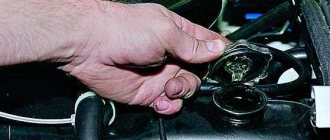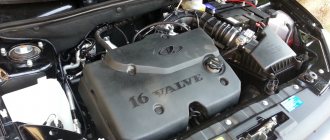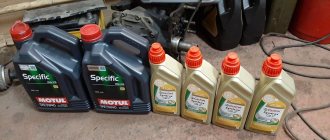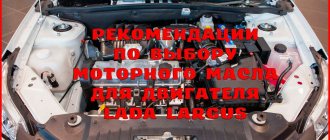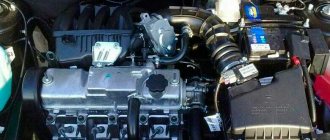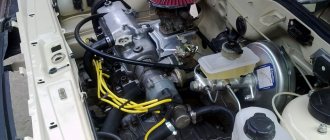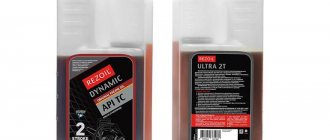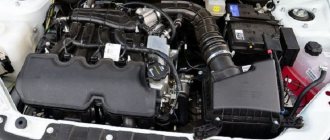VAZ 2107 was produced from 1982 until 2012. During this time, he managed to become a truly people's car. And no wonder. Cheapness, good reliability of components and assemblies, as well as the ability to repair a car almost “on the knee”. As you know, the “heart” of a car is the engine. And in this article the VAZ 2107 engine will be discussed in detail.
What engine can be installed on this car?
Initially, 2 types of engines were installed on the VAZ 2107 model, these are:
- VAZ 2103, with a working volume of 1.5 liters
- VAZ 2106, with a working volume of 1.6 liters
Let's look at them next.
There were also 1.3 L and 1.2 L engines, but they are very few in number and practically never found.
It is also possible to install an engine from a VAZ with front-wheel drive, but it is too labor-intensive and unjustified.
This is interesting! Sometimes the English letter “i” is added before the name of the car. This means that the VAZ 2107 engine is an injector.
Injector – fuel sprayer. Nozzle. The principle of operation of injection gasoline engines is very similar to diesel engines.
Engine VAZ 2103
Specifications
The main characteristics of the engine are presented in the table below:
Download .xls file xls Download picture pic Send to email mail
| OPTIONS | MEANING |
| Year of production of engines of this type | 1972 – our time |
| Supply system | Injector/carburetor |
| engine's type | Row |
| Number of pistons | 4 |
| Cylinder block material | cast iron |
| Cylinder head material | aluminum |
| Number of valves per cylinder | 2 |
| Piston stroke | 80 mm |
| Cylinder diameter | 76 mm |
| Engine capacity | 1452 cm 3 |
| Power | 71 l. With. at 5600 rpm. |
| Maximum torque | 104 Nm at 3600 rpm. |
| Compression ratio | 8.5 units |
| Oil volume in crankcase | 3.74 l |
This engine uses AI-93 fuel. In practice, motorists can fill in completely different fuels. The most common deviations from the norm are the flooding of AI-92 and AI-95. You can read more about this below.
- According to available data, fuel consumption in urban conditions is 9.4 liters per 100 km.
- On a flat road at cruising speed it will already be 6.9 liters per 100 km.
- In mixed mode, consumption will be from 8 to 9 liters per 100 km. Such figures do not allow us to call this engine economical, but in this case a lot depends on the driver himself.
- Another parameter that depends on the driver is oil consumption per 100 km. For the average driver of a car with this engine, it is 700 g per 100 km. This, of course, is not small, but with careful driving you can reduce this consumption down to 450-500 g/100 km.
- The weight of the 2103 engine when fully assembled is 121 kg.
Its dimensions (characteristics are indicated in millimeters):
| Height | Width | Length |
| 665 | 541 | 565 |
Chevrolet Small-Block
Atmospheric or compressor V8, lower cylinder, volume 5.7-7.0 liters
Advantages: large displacement, good boost potential, abundance of spare parts for tuning
The slang name “Small-block” refers to several families of lower V8 engines with a cast iron or aluminum block, which were and are still installed on full-size pickups, SUVs and sports cars of the General Motors concern - Chevrolet Silverado, Chevrolet Tahoe, Chevrolet Corvette and others like them. them. Over their half-century history, they have achieved almost perfection: the top versions already develop 500-600 horsepower right off the assembly line. Motors are produced in millions of copies, and for a swap you don’t even have to look for a donor: the GM Performance Parts department offers motors separately - especially for motorsports and tuning.
In the USA, these engines are installed everywhere: in SUVs and European sedans, small roadsters and crazy drag racing cars. Our professional drifters have spotted them: American engines are installed in Nissan Silvia and Skyline, BMW third series and Toyota Supra. Side-by-side driving specialists are attracted by high power, traction and ideal response to the gas pedal, coupled with excellent reliability - it is almost impossible to achieve all this at once from small-volume Japanese turbo engines.
Features of operation and maintenance
- Fuel selection
It was said earlier that many drivers cannot decide on the type of fuel used for their engine on the VAZ 2107. And if with AI-92 everything is simple, since its composition is very similar to AI-93, then with AI-95 everything is not so smooth.
Increasing the octane number leads to an increased risk of valve burnout, but gives a small increase in power. The engine begins to run smoother and more stable.
But the designers still took into account the possibility of using AI-95 gasoline. You just need to correctly set the ignition timing on your car (if you have a conventional carburetor engine) or reflash the engine control unit (if your VAZ 2107 engine is fuel-injected). But usually even this is not required. Engines of this brand are very durable and not picky about the type of fuel (within reasonable measures).
- Change of oil
Changing the oil on any engine must be approached with the utmost seriousness. Poor quality oil can lead to not very pleasant consequences, such as accelerated wear of main components and assemblies.
The ability to select oil is a real skill. Taking well-known brands is not always safe, since you are very likely to come across a counterfeit from dishonest companies. At best, you will not receive the positive qualities that this company has. At worst, you will have to carry out major repairs.
You shouldn't buy unknown brands either. In this case, you are buying a pig in a poke. You can buy oil that is of a quality that is not inferior to expensive analogues, or you can end up with expensive repairs. It is best to buy oil in specialized stores, where you can get at least some explanation and compensation.
Another important parameter is the oil class according to the international nomenclature. True, everything is simpler here. You just need to take the oil that the manufacturer himself recommends.
The manufacturer (AvtoVAZ) for VAZ 2107 engines and other models with this type of engine recommends:
- 5W-30;
- 5W-40;
- 10W-40;
- 15W-40.
You need to take about 4 liters of oil. When changing 3.5 liters of oil is usually enough. It’s better to carry the rest with you in the trunk, since oil consumption in this engine leaves much to be desired.
- Changing the oil in the VAZ 2107 engine
The procedure itself is quite simple and should not raise any questions. It is better to change the oil on a VAZ 2107 in the warm season.
- First you need to start the car and warm it up to operating temperature. Then turn it off and let the oil fall back into the crankcase. This will take about half an hour. During this time, we prepare a receiving container with a volume of 4-5 liters, as well as new oil, a watering can and a hose.
- Use a special wrench to unscrew the plug on the crankcase and wait for the old oil to drain out.
- If you change the type of oil or brand, you must also take flushing oil, which will clean the engine of the remnants of the old one. We pour it in the same way.
- Then we tighten the crankcase cover and fill in new oil through the neck on the cylinder head. We measure the level with a dipstick. It should be somewhere between the MIN and MAX marks. Please note that oil is not water and it cannot quickly sink into the crankcase, and therefore after a short stop the oil level in the crankcase will rise a little more.
Usually, along with changing the oil, the oil filter is also changed. It's even simpler here:
- We unscrew the old one using a special tool (you can also use an ordinary rope), lubricate the o-ring of the new filter with oil and screw it in place of the old one.
- Adjustment of valves
Adjusting valves is a rather complicated process and requires certain skills and tools. Actually, it is advisable to entrust the valve adjustment itself to competent specialists, but if you want to do everything yourself, then this video is for you:
Major repairs and maintenance
If valve adjustment can be done at home, then major engine repairs should only be entrusted to specialists.
During a major overhaul, all components and assemblies of the VAZ 2107 engine are checked for serviceability. They will check for you:
- Valve condition, adjustment;
- Chain, chain tension;
- Condition of oil seals, valve stem seals;
- Geometry of the cylinder block;
- Condition of the pistons, crankshaft, pins, connecting rods;
- Wear of compression rings;
- Condition of the oil pump and coolant pump.
If damaged, the part will be replaced. The cylinder block will be bored out, which will increase the combustion chamber and working volume. After this procedure, the car will be run-in for several thousand kilometers.
Typically, running-in lasts 5-10 thousand km. At this time, it is not advisable to give the engine heavy loads. After completing this procedure, your engine will make you happy.
Malfunctions
1. Engine won't start
| Cause of failure | Elimination method |
| No fuel in carburetor | |
| Fuel line clogged | Blow out the fuel line, flush the fuel tank |
| Carburetor and fuel pump filters are clogged | Wash filters and replace if necessary |
| Ignition system is faulty | Check the ignition system, replace broken parts |
| The carburetor air damper does not open at the first flashes in the cylinders | Eliminate leaks in the carburetor starting device |
| The carburetor solenoid valve does not open when the ignition is turned on: | |
| break in the wire going to the valve | Check the wire and its connections, replace the damaged wire |
| solenoid valve faulty | Replace valve |
2. Knocking noise from the crankshaft main bearings
Usually the knock is dull, metallic. It is detected when the throttle valves are opened sharply at idle. Its frequency increases with increasing crankshaft speed. Excessive axial clearance of the crankshaft causes a sharper knock with uneven intervals, especially noticeable with a gradual increase and decrease in the crankshaft speed.
| Cause of malfunction | Elimination method |
| Ignition too early | Adjust the ignition timing |
| Insufficient oil pressure | Check oil pressure |
| Flywheel mounting bolts are loose | Tighten the bolts to the recommended torque |
| Increased clearance between journals and main bearing shells | Sand the journals and replace the bearings |
| Increased clearance between thrust rings and crankshaft | Replace thrust half-rings with new ones or thicker ones |
Engine tuning
The most popular types of tuning for engines of this type are increasing the displacement, replacing the camshaft, installing a zero-resistance filter and direct-flow exhaust.
The most effective way (and the most expensive) is to install a turbo kit.
- Increase in working volume
The design of the VAZ 2103 engine allows for a good increase in displacement, since its cylinder block is almost identical to the VAZ 2106 engine block. And when this block is bored, it can be made to fit the piston and rings of the VAZ 2106 engine.
Thus, we get an increase in displacement, which increases fuel consumption and power. If even this is not enough, then they sharpen the pistons on the valve side and install a crankshaft from the Niva, which also increases the working volume. Presumably after these operations you can get an engine with a displacement of 1.7 liters, sometimes 1.8 liters.
- Installing a new camshaft
This modification does not increase engine power, but changes the nature of its operation. In most cases, they try to install a camshaft that will transfer maximum torque to as low a speed as possible. This makes the engine more responsive at lower speeds, which has a very good effect when driving at low engine speeds. The best option for such a modification is a camshaft from Niva 21213.
- Installation of direct-flow exhaust and zero-resistance filter
The most popular modification. First of all, it's pretty cheap. Secondly, it allows the car owner to show off to neighbors in the garages. In fact, it does not have any practical benefit for the stock engine. Allows you to feel a slight increase in power only at high speeds.
It is quite effective when installing Turbo, since it does not put pressure on the engine, which is now capable of developing enormous power. Direct-flow exhaust is not convenient due to increased exhaust sound. It is dangerous to use the filter in wet weather, as it can let water into the engine, causing water hammer.
- Installation of turbocharging
The most expensive and effective way to increase engine power, while its resource sharply drops by 2-3, sometimes 4-5 times.
Requires deep exhaust tuning:
- Installing T-Valves
- Imported rings and forged pistons
- Lightened crank feces
- Intercooler and much more.
It is also necessary that your VAZ 2107 engine be fuel-injected. The carburetor can simply burst due to such high pressure. This article will not describe the procedure for installing Turbo on a VAZ 2107. There is enough such information on the World Wide Web. Here we will simply indicate a price of approximately 15% of the cost of the car. If you are ready to spend your money on this, go for it.
What to take?
Which engine would you prefer? Write to us in the comments. And if you are already the owner of Vesta, then indicate what engine your car has and whether you are satisfied with the engine in particular and the car in general.
- If you need to protect your car radiator from stones and other troubles, you can always make a protective mesh with your own hands or install a model radiator protection.
- It is important not just the presence of a tow rope in the trunk of the car, but also its quality! Towing and towing ropes, as well as accessories for them, are available in our online store!
Photo: “Behind the Wheel” and AVTOVAZ
Engine VAZ 2106
The design of the VAZ 2106 engine is almost completely identical to the VAZ 2103 engine, with the exception of some nuances, such as engine displacement.
Characteristics
| Year of production of engines of this type | 1976 – our time |
| Supply system | Injector/carburetor |
| engine's type | Row |
| Number of pistons | 4 |
| Cylinder block material | cast iron |
| Cylinder head material | aluminum |
| Number of valves per cylinder | 2 |
| Piston stroke | 80 mm |
| Cylinder diameter | 79 mm |
| Engine capacity | 1569 cm 3 |
| Power | 75 l. With. at 5400 rpm. |
| Maximum torque | 116 Nm at 3000 rpm. |
| Fuel consumption (100 km): | 10.3 l |
| city | 7.4 l |
| track | 10 l |
| mixed |
Dimensions and Weight are identical (see paragraph Characteristics of the VAZ 2103 engine).
Features of operation
Completely identical to the VAZ 2103 engine (see similar VAZ 2103 engine design). The oil volume in the crankcase is also the same and is 3.75 liters.
Engine tuning
Also identical to the VAZ 2103 engine. See the section Engine tuning (VAZ 2103). The features of boring will be described below.
- Increase in working volume
Identical to the point “Increasing the displacement of the VAZ 2103 engine” with the exception that this engine does not require sharpening the cylinder block. It has already been bored to the required values.
This concludes the article. We hope that you were interested and found answers to the questions: “What engine can be installed in my car?”, “How to increase engine power without losing reliability?” and “What is an injector?” As you can see, despite its modest engine performance, the VAZ 2107 has the potential for modernization and in terms of speed characteristics it can be on par with modern cars.
This is interesting: Types of carburetors

